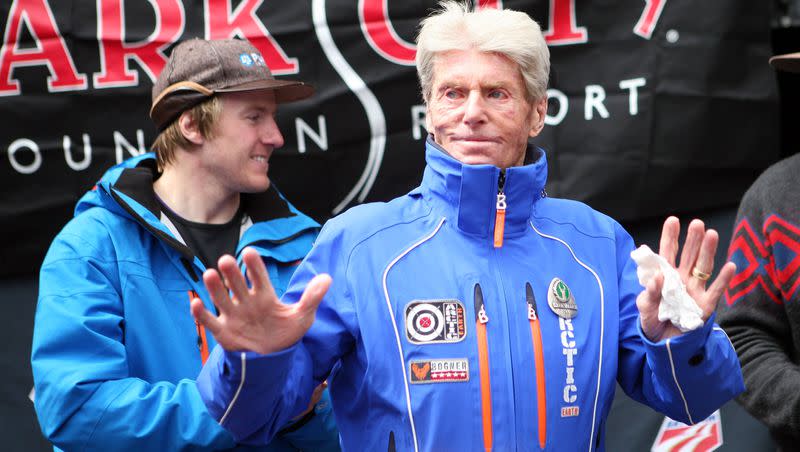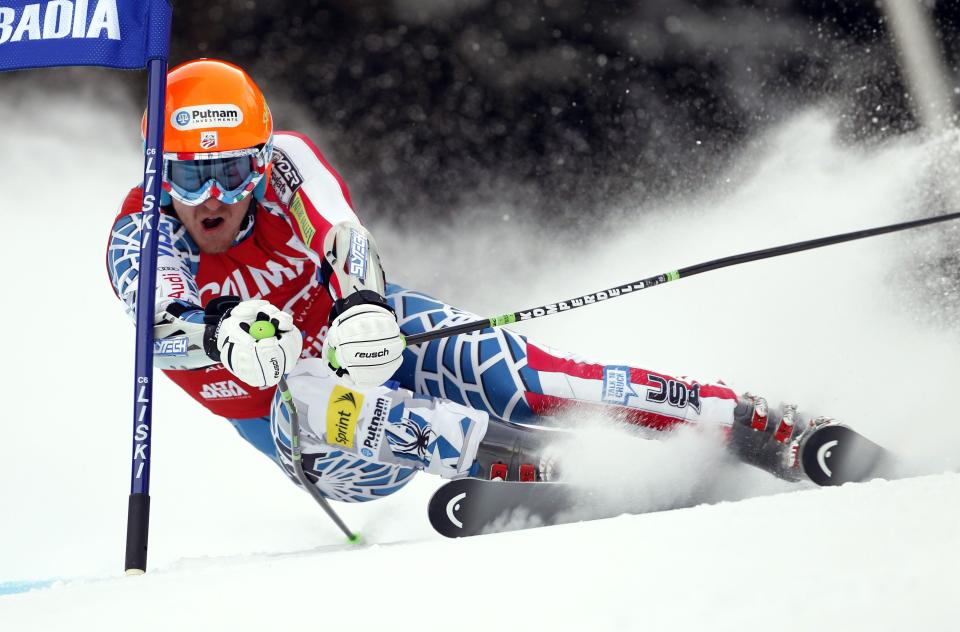They won triple crowns in different eras, but skiers race into Hall of Fame together

- Oops!Something went wrong.Please try again later.
- Oops!Something went wrong.Please try again later.
In the history of the world, just five male skiers have won what is known as the triple crown — finishing first in three different disciplines at either the World Championships or Olympic Games.
Two of them will be inducted into the Utah Sports Hall of Fame on Monday night, Sept. 18.
Park City native son Ted Ligety and Park City adopted son Stein Eriksen will increase the Hall’s numbers to 256 athletes, joining a 2023 class that also includes basketball coach Dave Rose, fencer Julie Thompson Seal and sportswriter Tom Wharton.
The 38-year old Ligety, who retired from competitive ski racing just 21⁄2 years ago, admits he is as surprised as anyone that he’s sharing the night with the legendary Stein Eriksen, who died at the age of 88 seven years ago.
“I would’ve thought Stein would be in the Hall of Fame long before me,” said Ligety.
But such is the nature of halls of fame and their sometimes mystifying selection processes.
Despite the noticeable age gap, there is a common thread that ties the two triple-crown winners together:
We’d likely never have heard of either one of them if they hadn’t figured out how to turn differently than the other guys.
Eriksen with his reverse shoulder turn. Ligety with his continuous arc to arc turning technique.
Skiing for Norway in his first Olympics in 1948 in Switzerland, Stein’s best finish was 29th place in the slalom. Disappointed, he returned home determined to find a better way. In those days, the poles skiers turned around were rigid obstacles, unlike the bendable ones later on. Hitting a gate usually guaranteed a ruined run.
In thinking it through, Stein decided to go against conventional wisdom and use the shoulder nearest the pole to lead into the turn. This reverse-shoulder style allowed him to turn closer to the gates.
In the next Olympics, on home snow in Oslo in 1952, the Eriksen legend was born when Stein won gold in the giant slalom and silver in the slalom.
Two years later, at the World Championships in Are, Sweden, he won gold in the giant slalom, slalom and combined to become the second skier to win the coveted triple crown (Emile Allais of France was the first, in 1937).

As for Ligety, who started skiing at the age of 2 on the runs at Park City, he spent countless hours honing and refining a style that linked turns together practically nonstop. As The New York Times described the technique in an article prior to the Sochi Olympics, “Ligety has always forcefully pressured and created an arc in his skis sooner on turns than other racers.”
Ironically, linking turns like that allowed him to ski farther away from the gates, in direct contrast to Eriksen a half-century earlier. But even though Ligety traveled more distance than other racers, his turns generated the kind of speed that won races sometimes by seconds instead of tenths of seconds.
For seven years, from 2008 through 2014, Ligety was the world’s preeminent giant slalom skier. During that time, he won gold in 24 World Cup races, was the world’s giant slalom overall champion five times, and capped it off with Olympic gold at Sochi in 2014, following his dominating performance at the 2013 World Championships in Austria when he finished first in the giant slalom, super-G and combined and became just the fifth man to win the triple crown (between Ted and Stein, Toni Sailer of Austria did it twice, in 1956 and 1958, and Jean-Claude Killy of France pulled off the feat at the 1968 Olympics).
Entering a Hall of Fame next to Eriksen, said Ligety — who is now Deer Valley’s ambassador of skiing, Stein’s old post — “is pretty amazing. Stein was such a figurehead, an icon for skiing, an icon for Park City. I don’t think I can pretend to live up to that level of legacy.”
But he does acknowledge they were both innovators.
“He was absolutely an innovator, both on the technique side and on the freestyle skiing side too,” he said, “I was always very conscious about how I went about my skiing. I was always trying to figure out ways I could use my strengths to my advantage.”
Bjorn Eriksen, Stein’s son who will be representing him at the induction ceremonies, said his father would be pleased to be in the same class as Ligety.
“It’s cool to see Ted did something similar to what my dad did. There’s a lot of ingenuity there,” he said. “They both found techniques that allowed them to push a little bit harder in a sport where the margins are so slim.”
And yes, he too is “kinda surprised” that Stein Eriksen, who was put into the U.S. National Ski and Snowboard Hall of Fame way back in 1982 and was knighted by the king of Norway in 1997, among a long line of previously bestowed honors, hasn’t gone into the Utah Sports Hall of Fame before now.
“But it’s an honor, nonetheless,” he said. “He made a lot of contributions to the sport of skiing in Utah.”

